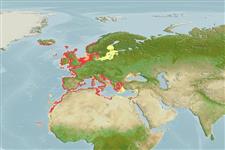Preferred temperature (Ref.
115969): 8.8 - 20.1, mean 11 (based on 420 cells).
Phylogenetic diversity index (Ref.
82804): PD
50 = 0.5005 [Uniqueness, from 0.5 = low to 2.0 = high].
Bayesian length-weight: a=0.00724 (0.00559 - 0.00939), b=3.11 (3.03 - 3.19), in cm Total Length, based on LWR estimates for this species (Ref.
93245).
Nivel trófico (Ref.
69278): 2.6 ±0.32 se; based on food items.
Resiliencia (Ref.
120179): Medio, población duplicada en un tiempo mínimo de 1.4-4.4 años (K=0.12-0.17; tm=3; tmax=25).
Fishing Vulnerability (Ref.
59153): High vulnerability (63 of 100).
Climate Vulnerability (Ref.
125649): Moderate to high vulnerability (51 of 100).
